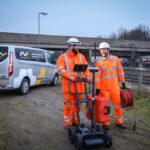In this guest writer article, SEP Rail Services’ Managing Director, Rikki Morrow, explains why utility mapping is key to safe, efficient ground works.
Every ground-breaking moment in rail and civil engineering signifies progress, yet beneath the surface lies an intricate network of utilities and structures providing crucial unseen support to the world above.
Striking a utility poses not only a risk, but also embodies a potential disruption, a safety concern, and a compliance challenge.
But what if you could possess the ability to know what lies beneath your feet before a single piece of ground is broken? SEP Rail Services transforms this vision into reality by offering a solution that protects the workforce, minimises disruption and avoids a costly utility strike.
Safeguaring people and ensuring compliance
Every time your team commences groundwork, there’s a potential of encountering a utility. Safeguarding your team and clients and ensuring compliance are our utmost priorities. It’s the manner in which we accomplish this that is important.
From power and gas to water, telecommunications, drainage, and sewers, utilising cutting-edge technology and unparalleled expertise, SEP Rail Services promotes uninterrupted operations and a secure working environment for all.
Utility mapping isn’t a ‘one size fits all’ service. Each project holds distinct requirements, and we take pride in being one of the most diverse organisations of our kind, providing a spectrum of services that complement every stage of your project.
Employing non-destructive techniques ensures minimal project delays and eases financial burdens. With a considerable amount of new development occurring on brownfield sites, the presence of buried services is becoming more of a likelihood than a possibility.
Employing technology to create a map of potential hazards
While sourcing statutory undertakers’ records provides a starting point, it can often be time-consuming and offer outdated data. Through Network Rail-approved survey equipment, SEP Rail Services crafts a comprehensive map of potential hazards beneath our feet.
Suppose your objective is to detect underground power cables or a specific power cable. In such cases, an Electromagnetic Location (EML) tool is utilised by SEP Rail Services’ engineers to detect electromagnetic signals emitted by power cables or the energy from low-frequency communications signals which has ‘coupled’ onto metal services. A final power and radio sweep will capture any additional electrical apparatus within the area.
However what about utilities that aren’t metallic, like plastic and concrete pipes, or subterranean structures and voids?
In such instances, Ground Penetrating Radar (GPR) accurately locates and maps utilities and structures beneath your site. GPR operates by transmitting and receiving a signal into the ground from the system antenna. The received signal contains information from any target reflections along the signal path and where in time the reflection occurred. This information is then translated to position and depth by the GPR software.
A Global Navigation Satellite System (GNSS) receiver or Total Station is then utilised to pick up service locations, and findings are plotted onto a user-friendly topographical survey, ready for the next stage of works to commence.
Consequently, there are distinctions between the two technologies. GPR has the potential to recover the locations of more underground features than Electromagnetic Location methods since it can ‘see’ both metallic and non-metallic targets within the same scan. However, it does not identify whether it’s metal, a cable, a pipe, or a drain.
SEP Rail Services integrates all non-destructive surveying methods to craft a detailed utility map that detects all unseen obstacles before a single piece of ground is broken.
By adhering to PAS128 and Network Rail standards the company ensures the smooth completion of intricate ground works across rail, civil engineering, and construction.
And, with a focus on cutting-edge technology, diverse expertise, and a commitment to industry standards, SEP Rail Services is better placed than ever to deliver accountable utility mapping across the United Kingdom.
For more information about SEP Rail Services click here.

